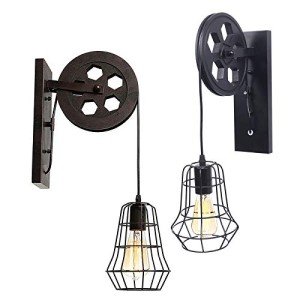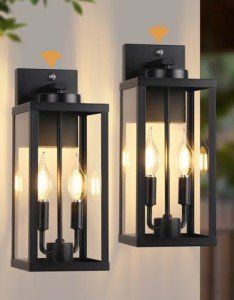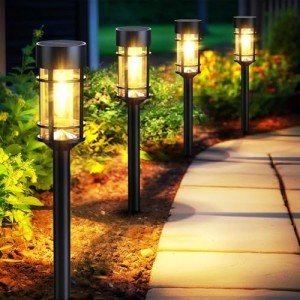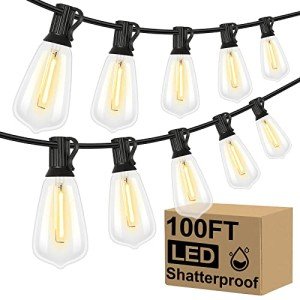How to Choose the Best Outdoor Lighting for Your Home
Outdoor lighting is more than just a practical addition to your home—it’s a way to enhance curb appeal, improve safety, and create an inviting atmosphere. Whether you’re illuminating a pathway, highlighting your landscaping, or securing your property, choosing the right outdoor lighting requires careful consideration of function, style, and efficiency. Here’s a comprehensive guide to help you select the best outdoor lighting for your home.
1. Define Your Purpose
The first step in choosing outdoor lighting is identifying its primary function. Different areas of your home may require distinct lighting solutions. Ask yourself:
-
Safety and Security: Do you need to light up entryways, driveways, or dark corners to deter intruders and ensure safe navigation? Motion-sensor floodlights or well-placed wall lights work well here.
-
Ambiance: Are you aiming to create a warm, welcoming vibe for your patio or garden? String lights, lanterns, or soft accent lighting can set the mood.
-
Accentuation: Want to showcase your home’s architecture or highlight landscaping features like trees or flower beds? Spotlights or uplights are ideal for drawing attention to specific elements.
By clarifying your goals, you can narrow down the types of fixtures and placements that will best suit your needs.
2. Choose the Right Type of Lighting
Outdoor lighting comes in a variety of styles and technologies. Here are some popular options:
-
Wall Lights: Mounted on exterior walls, these are great for porches, garages, or entryways. They provide both illumination and a decorative touch.
-
Path Lights: Low-level fixtures that line walkways or driveways, ensuring safe passage while adding charm.
-
Floodlights: Powerful and broad-beamed, these are perfect for security or illuminating large areas like backyards.
-
Spotlights: Focused beams that highlight specific features, such as statues, trees, or architectural details.
-
String Lights: Versatile and trendy, they’re excellent for patios, decks, or pergolas, creating a cozy, festive feel.
-
Deck and Step Lights: Small, recessed lights that improve safety on stairs or decks without overwhelming the space.
Consider a mix of these types to achieve a balanced and functional outdoor lighting scheme.
3. Pick the Right Bulb Technology
The type of bulb you choose affects energy efficiency, brightness, and ambiance. Here’s a breakdown of your options:
-
LEDs: Energy-efficient, long-lasting, and available in various color temperatures (warm to cool), LEDs are the go-to choice for most modern outdoor lighting.
-
Solar-Powered: Ideal for eco-conscious homeowners, these lights charge during the day and work well in sunny climates. They’re best for low-level lighting like path or accent lights.
-
Halogen: Brighter and more affordable upfront, but less energy-efficient and shorter-lived than LEDs.
-
Incandescent: Traditional bulbs with a warm glow, though they’re being phased out due to inefficiency.
For most homes, LEDs strike the perfect balance between performance and cost savings over time.
4. Consider Brightness and Color Temperature
Brightness, measured in lumens, and color temperature, measured in Kelvin (K), play a big role in how your lighting feels:
-
Lumens: For security, aim for higher lumens (700–1,300+). For ambiance or pathways, lower lumens (100–400) are sufficient.
-
Color Temperature: Warm white (2,700–3,000K) creates a cozy, inviting look, while cool white (3,500–4,500K) offers a crisp, modern feel. For security, daylight tones (5,000K+) provide maximum visibility.
Test different options to see what complements your home’s aesthetic and meets your functional needs.
5. Match Your Home’s Style
Outdoor lighting should blend seamlessly with your home’s architecture and design. For example:
-
Traditional Homes: Lantern-style wall lights or wrought-iron path lights enhance classic charm.
-
Modern Homes: Sleek, minimalist fixtures in stainless steel or matte black align with contemporary aesthetics.
-
Rustic Homes: Warm-toned string lights or weathered bronze lanterns add a cozy, countryside vibe.
Take cues from your home’s exterior materials, colors, and overall vibe to ensure a cohesive look.
6. Plan for Energy Efficiency
Outdoor lights often stay on for hours, so efficiency matters. Beyond choosing LED or solar options, consider these features:
-
Timers: Automatically turn lights on at dusk and off at dawn.
-
Motion Sensors: Activate lights only when needed, saving energy and adding security.
-
Smart Lighting: Control lights via an app or voice assistant, adjusting brightness or schedules remotely.
These upgrades not only reduce your energy bill but also make your lighting system more convenient.
7. Think About Placement and Scale
Proper placement ensures your lighting serves its purpose without overwhelming your space:
-
Height: Wall lights should sit at eye level (about 5–6 feet off the ground), while path lights should be spaced 6–8 feet apart for even coverage.
-
Distance: Avoid clustering lights too closely—spread them out for a natural effect.
-
Scale: Choose fixtures proportional to your home’s size. Oversized lanterns might dwarf a small porch, while tiny lights could get lost on a sprawling estate.
Sketch a rough layout of your property to visualize where lights will have the most impact.
8. Weatherproofing and Durability
Outdoor lights face rain, wind, and temperature swings, so durability is key. Look for:
-
IP Rating: An Ingress Protection (IP) rating of IP65 or higher ensures resistance to dust and water.
-
Materials: Opt for corrosion-resistant finishes like stainless steel, aluminum, or powder-coated metals, especially in coastal areas prone to saltwater exposure.
Check warranties and reviews to ensure your fixtures can withstand your local climate.
9. Test Before You Commit
Lighting looks different at night than it does in a store. If possible, test fixtures in your yard or purchase from retailers with good return policies. Pay attention to how the light interacts with your space—does it cast harsh shadows, or does it create the glow you envisioned?
10. Set a Budget
Outdoor lighting ranges from budget-friendly solar stakes to high-end designer fixtures. Decide how much you’re willing to spend, factoring in installation costs if you’re hiring a professional. A mix of affordable and statement pieces can deliver both quality and value.
Final Thoughts
Choosing the best outdoor lighting for your home is about balancing practicality with personality. Start by assessing your needs, exploring fixture and bulb options, and aligning your choices with your home’s style. With thoughtful planning, your outdoor lighting can transform your property into a safer, more beautiful space you’ll enjoy day and night.
Ready to get started? Take a walk around your home at dusk to spot the areas that need light, and let your vision guide you from there. Happy illuminating!




